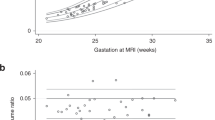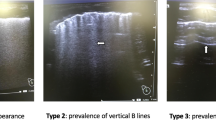Abstract
Objective:
To compare the neonatal outcome of infants delivered before 39 weeks' gestation following documentation of fetal lung maturity before and after the lamellar body count (LBC) threshold was increased from 30 000 to 50 000 LB/ul. We discuss the algorithm employed for testing fetal lung maturity, the cost of testing and potential savings.
Material and methods:
We studied the outcome of infants delivered electively before 39 weeks' gestation after fetal lung maturity was documented by amniotic fluid analysis. We compared the outcome of neonates born before and after the LBC threshold was increased.
Results:
Our cohort included 527 neonates who were divided into two groups: 264 who underwent fetal lung maturity studies before the change in LBC threshold and 263 who underwent testing after the change. In the first group, 158 neonates met the criteria of LBC >30 000 LB/ul and were delivered without further testing. The second group included 154 neonates who were mature by LBC >50 000 LB/ul and were delivered. Seven of the neonates born in the first group required admission to the neonatal intensive care unit (NICU), whereas in the second group only two neonates required admission (P=0.02). Additionally, 16 neonates in the first group required respiratory assistance compared with six in the second group (P=0.04). The overall neonatal complication rate was significantly higher in the first group (P=0.001).
Conclusion:
Changing the LBC threshold resulted in a significant decrease in neonatal morbidity. Employing the algorithm, we described for testing fetal lung maturity is cost effective, and more importantly, represents sound evidence-based medical management.
This is a preview of subscription content, access via your institution
Access options
Subscribe to this journal
Receive 12 print issues and online access
$259.00 per year
only $21.58 per issue
Buy this article
- Purchase on Springer Link
- Instant access to full article PDF
Prices may be subject to local taxes which are calculated during checkout

Similar content being viewed by others
References
American College of Obstetrics and Gynecology ACOG. Educ Bull. No. 230 Nov. 1996; 1–7.
Neerhof MG, Haney EL, Silver RK, Ashwood ER, Lee IS, Piazze JJ et al. Lamellar body counts compared with traditional phospholipid analysis as an assay for evaluating fetal lung maturity. Obstet Gynecol 2001; 97: 305–309.
Neerhof MG, Dohnal JC, Ashwood ER, Lee IS, Anceschi MM . Lamellar body counts: a consensus on protocol. Obstet Gynecol 2001; 97: 318–320.
Ventolini G, Neiger R, Hood D, Belcastro C . Update on assessment of fetal lung maturity. J Obstetr Gynaecol 2005; 25: 535–538.
Stutchfield P, Rhiannon W, Russell I . On behalf of the Antenatal Steroids for Term Elective Cesarean Section (ASTECS) Research Team. Antenatal betamethasone and incidence of neonatal respiratory distress after elective caesarean section: pragmatic randomized trial. BMJ 2005; 186: 1–6.
Wijnberger LD, Huisjes AJ, Voorbij HA, Franx A, Bruinse HW, Mol BW et al. The accuracy of lamellar body count and lecithin/sphingomyelin ratio in the prediction of neonatal respiratory distress syndrome: a meta-analysis. BJOG 2001; 108 (6) 08: 583–588.
Hunter LA, McKenna DS, Baptista MAC . Comparison of lamellar body counts using light microscopy with standard coulter counter techniques to assess fetal lung maturity. Gynecol Obstet Invest 2005 (17) 61 (1): 29–33.
Kaplan LA, Chapman JF, Bock JL, Santamaria E, Clejan S, Huddleton DJ et al. Prediction of respiratory distress syndrome using the abbott FLM-II amniotic fluid assay. Clin Chim Acta 2002; 326: 61–68.
Torday JS, Rehan VK . Testing for fetal lung maturation: a biochemical ‘window’ to the developing fetus. Clin Lab Med 2003; 23: 361–383.
Karcher R, Sykes E, Batton D, Uddin Z, Ross G, Hockman E et al. Gestational age-specific predicted risk of neonatal respiratory distress syndrome using lamellar body count and surfactant-to-albumin ratio in amniotic fluid. Am J Obstet Gynecol 2005; 193: 1680–1684.
Author information
Authors and Affiliations
Corresponding author
Rights and permissions
About this article
Cite this article
Ventolini, G., Neiger, R., Hood, D. et al. Changes in the threshold of fetal lung maturity testing and neonatal outcome of infants delivered electively before 39 weeks gestation: implications and cost-effectiveness. J Perinatol 26, 264–267 (2006). https://doi.org/10.1038/sj.jp.7211501
Received:
Revised:
Accepted:
Published:
Issue Date:
DOI: https://doi.org/10.1038/sj.jp.7211501



